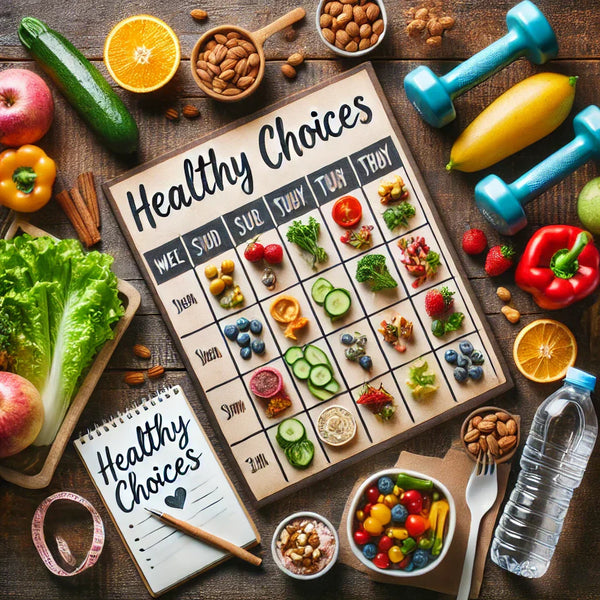6 reasons why getting a monthly meal plan is worth every dirham!
by Elloww Team

In today’s busy world, maintaining a healthy lifestyle while juggling work and personal commitments can be a real challenge. Often, the easiest way to satisfy hunger is to order fast food or take-out. However, this can be detrimental to your health and your wallet. That’s where monthly meal planning comes in as a time-saving and cost-effective solution. By using a weekly meal planner and organizing your meals ahead of time, you can enjoy nutritious, delicious food without the stress of last-minute decisions. Here are six reasons why adopting a monthly meal plan is worth every dirham.
1. Promotes Healthy Eating
When you rely on spontaneous meal choices, you’re more likely to opt for quick, unhealthy options. With meal planning, you’re able to create a monthly calendar of meals that align with your health goals. By taking the time to plan your week meals, you’ll have healthy options available at all times. A weekly meal planner allows you to balance your macronutrients, include more vegetables, and control the ingredients in each meal.
This organized approach ensures you’re not reaching for fast food or unhealthy snacks. Plus, you can customize your month meals to suit your weight loss or nutritional goals. Whether you’re cutting carbs, following a vegan diet, or eating for muscle gain, the meal planning process ensures that every meal is tailored to your needs. You’ll no longer need to make unhealthy food choices when hunger strikes because you’ll always have a healthy meal ready.
2. Provides More Variety
Meal planning encourages a diverse diet by ensuring you don’t fall into a cooking rut. Many of us end up preparing the same meals every week, which can lead to boredom and a lack of nutrients. By creating a monthly meal plan, you’ll have the flexibility to introduce a variety of meal ideas throughout the month. You can experiment with new recipes, explore different cuisines, and try new ingredients that you wouldn’t normally think of when you’re rushing to make dinner on a single night.
Incorporating dinner ideas that you wouldn’t normally cook can also improve your health by providing your body with a broader range of vitamins and minerals. Whether you decide to use a slow cooker meal for an easy dinner or try a new stir-fry recipe, your meal plan can keep your diet exciting and nutritionally balanced. Plus, you’ll avoid the temptation to eat the same meals repeatedly, ensuring that you’re enjoying a variety of flavors and nutrients throughout the month.
3. Helps with Portion Control
One of the most challenging aspects of eating healthily is controlling portion sizes. Without a clear plan, it's easy to overeat, especially when eating out or ordering take-out. Meal planning helps you avoid this pitfall by allowing you to portion your meals according to your dietary needs. By carefully measuring your ingredients, you can ensure you're eating the right amount of food for each meal.
When you plan out your meals for the entire month, you’ll find that you naturally start eating more reasonable portions, avoiding overindulgence. You can also track your portions using tools like a shopping list or even a Google calendar to schedule your meals and snacks. Over time, this strategy helps develop a better relationship with food and improves your ability to listen to your body’s hunger cues.
4. Prevents Food Waste
Food waste is a growing concern in many households, and it often occurs when we buy more food than we can consume. Whether it's a forgotten head of lettuce or leftover grains, food waste can add up. However, monthly meal planning helps you use all the groceries you buy, minimizing waste. With a well-structured plan, you can avoid over-purchasing items and ensure that everything in your fridge is used efficiently.
By creating a shopping list that reflects your meal plan, you can avoid buying unnecessary items, which means fewer groceries will end up being thrown away. Additionally, meal planning allows you to repurpose leftovers, ensuring that nothing goes to waste. If you have extra vegetables, for example, you can easily incorporate them into soups or stir-fries the following day. This careful management of ingredients helps reduce food waste and saves money in the long run.
5. Saves Time
After a long day, deciding what to cook can be stressful, especially when you’re hungry and don’t want to spend hours in the kitchen. Weekly meal planning eliminates the need for last-minute meal decisions, allowing you to focus on other priorities. With a set plan for the week, you’ll know exactly what to cook, which saves time and mental energy.
Planning ahead also allows you to prep your meals in bulk, such as making a large batch of soup or a slow cooker meal that can last several days. When you have meals already prepared, you can quickly heat them up, saving you valuable time. Whether you’re using a slow cooker meal for dinner or prepping ingredients ahead of time, meal planning helps streamline your cooking process and frees up time for other activities.
Moreover, using tools like Google calendar or a monthly calendar helps keep you organized. You can schedule when to prepare your meals, when to do your grocery shopping, and even plan for snacks throughout the day. This level of organization ensures you’re never scrambling to put together a meal at the last minute.
6. Saves Money
One of the most compelling reasons to invest in monthly meal planning is the potential to save money. When you plan your meals in advance, you can budget for your groceries more effectively and avoid unnecessary purchases. How often have you bought groceries for a recipe you never ended up making? By sticking to your shopping list, you’ll only buy the items you actually need for the week’s meals.
Buying in bulk can also help you save money, as many grocery stores offer discounts on bulk purchases. With meal planning, you’re more likely to buy staples in larger quantities (e.g., rice, pasta, canned vegetables), which will last longer and save you money in the long term. Furthermore, meal planning helps you avoid the temptation to order take-out or eat out, which can quickly become expensive. Instead, you’ll have healthy, home-cooked meals ready to go, saving you both time and money.
Another way meal planning can save you money is by allowing you to take advantage of sales and promotions. When you know what you’ll be eating for the week, you can shop strategically and stock up on items that are on sale. By buying in bulk and avoiding impulse purchases, you’ll find that your grocery bill decreases significantly.
Conclusion
In conclusion, adopting monthly meal planning can completely transform your approach to eating. Whether you’re trying to eat healthier, save time, reduce food waste, or stick to a budget, meal planning is an investment that pays off in many ways. By using a weekly meal planner to organize your week meals, you can ensure you’re always eating nutritious, satisfying meals. Planning ahead not only helps you stay on track with your health and fitness goals but also promotes better organization in your kitchen and grocery shopping.
With the help of tools like a Google calendar, you can keep your monthly calendar up to date with meal plan ideas, grocery lists, and preparation schedules. In the end, meal planning saves time, money, and energy while contributing to a healthier, more sustainable lifestyle. So, why not start planning your meals today? The benefits are well worth the investment!
FAQ's About Monthly Meal Planning
What is the first step in creating a monthly meal plan?
The first step in creating a monthly meal plan is to assess your dietary preferences, health goals, and available time. Start by selecting a variety of meals for the week, ensuring balance in macronutrients. Then, create a grocery shopping list based on these meals, factoring in any leftovers or repeat meals. This process provides structure for the entire month.
How do family activities impact meal planning?
Family activities, such as school events, sports, or social gatherings, significantly impact meal planning by influencing time available for cooking. It’s important to plan quick, easy-to-prepare meals on busy days and include options that can be made in advance, like casseroles or slow cooker meals. This ensures you stay on track with healthy eating despite a hectic schedule.
What kind of meals should be included first in a meal plan?
Start your meal plan by including balanced meals that cover all food groups: lean proteins, whole grains, and plenty of fruits and vegetables. Focus on easy-to-make meals that fit your time constraints, such as stir-fries, soups, or salads, while ensuring variety to prevent meal fatigue throughout the month.
How should a meal plan be reviewed and updated?
Review your meal plan regularly, ideally once a week or after two weeks, to assess what worked and what didn’t. Update the plan based on any new preferences, seasonal ingredients, or changes in your schedule. It’s helpful to adjust recipes, portion sizes, and shopping lists to improve the plan’s efficiency and effectiveness.
What should be done with the meal plan halfway through?
Halfway through the month, take time to review your progress and make necessary adjustments. This could mean swapping out meals that didn’t work or adding new ideas. Check your pantry and fridge to ensure you’re using up ingredients efficiently and avoid waste. This ensures your meal plan remains effective and fresh.




